

Folklore. A magic carpet - a carpet that can allegedly transport persons instantaneously or swiftly to a destination.
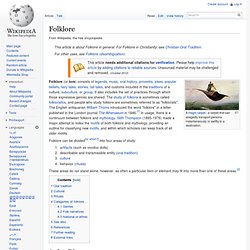
Folklore can be divided[by whom?] Into four areas of study: artifacts (such as voodoo dolls)describable and transmissible entity (oral tradition)culturebehavior (rituals) These areas do not stand alone, however, as often a particular item or element may fit into more than one of these areas.[2] Oral tradition[edit] While folklore can contain religious or mythic elements, it equally concerns itself with the sometimes mundane traditions of everyday life. Sometimes "folklore" is religious in nature, like the tales of the Welsh Mabinogion or those found in Icelandic skaldic poetry.
"Folktales" is a general term for different varieties of traditional narrative. Contemporary narratives common in the Western world include the urban legend. Vladimir Propp's classic study Morphology of the Folktale (1928) became the basis of research into the structure of folklore texts. List of dragons in mythology and folklore. From Wikipedia, the free encyclopedia This article is a list of dragons in mythology and folklore.
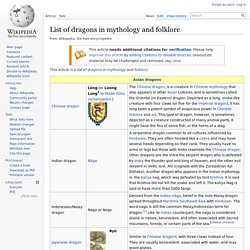
See also[edit] European dragon. European dragons are legendary creatures in folklore and mythology among the overlapping cultures of Europe.[1] In Western folklore, dragons are usually portrayed as evil, with exceptions mainly in Welsh folklore and modern fiction.
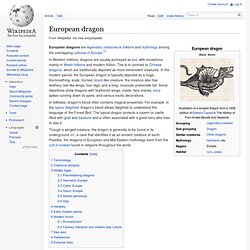
This is in contrast to Chinese dragons, which are traditionally depicted as more benevolent creatures. In the modern period, the European dragon is typically depicted as a huge, fire-breathing, scaly, horned, lizard-like creature; the creature also has leathery, bat-like wings, four legs, and a long, muscular prehensile tail. Some depictions show dragons with feathered wings, crests, fiery manes, ivory spikes running down its spine, and various exotic decorations. Terminology[edit] Classical antiquity[edit] Several vague incarnations of evil in the Old Testament were given the translation draco in Jerome's Vulgate, to undergo changes in meaning and become broad embodiments of evil.[3] Wawel Dragon. Fafnir. In Norse mythology, Fáfnir (Old Norse and Icelandic) or Frænir was a son of the dwarf king Hreidmar and brother of Regin and Ótr.
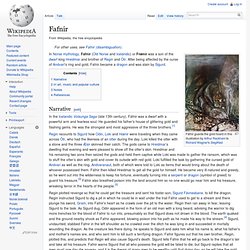
After being affected by the curse of Andvari's ring and gold, Fafnir became a dragon and was slain by Sigurd. Narrative[edit] In the Icelandic Volsunga Saga (late 13th century), Fáfnir was a dwarf with a powerful arm and fearless soul. He guarded his father's house of glittering gold and flashing gems. He was the strongest and most aggressive of the three brothers.[1] Regin then returned to Sigurd after Fafnir was slain. Some versions are more specific about Fáfnir's treasure hoard, mentioning the swords Ridill and Hrotti, the helm of terror and a golden coat of chainmail.[9] Jörmungandr. Sources[edit] The major sources for myths about Jörmungandr are the Prose Edda, the skaldic poem Húsdrápa, and the Eddic poems Hymiskviða and Völuspá.
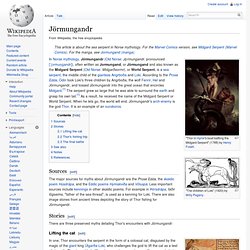
Less important sources include kennings in other skaldic poems. For example in Þórsdrápa, faðir lögseims, "father of the sea-thread", is used as a kenning for Loki. There are also image stones from ancient times depicting the story of Thor fishing for Jörmungandr. Stories[edit] There are three preserved myths detailing Thor's encounters with Jörmungandr: Lifting the cat[edit] Thor goes fishing for the Midgard Serpent in this picture from an 18th-century Icelandic manuscript.
Níðhöggr. Níðhöggr gnaws the roots of Yggdrasill in this illustration from a 17th-century Icelandic manuscript.
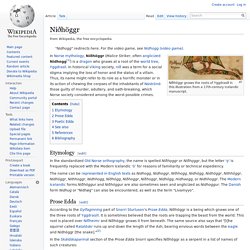
In Norse mythology, Níðhöggr (Malice Striker, often anglicized Nidhogg[1]) is a dragon who gnaws at a root of the world tree, Yggdrasil. In historical Viking society, níð was a term for a social stigma implying the loss of honor and the status of a villain. Thus, its name might refer to its role as a horrific monster or in its action of chewing the corpses of the inhabitants of Náströnd: those guilty of murder, adultery, and oath-breaking, which Norse society considered among the worst possible crimes. Etymology[edit] In the standardized Old Norse orthography, the name is spelled Níðhǫggr or Niðhǫggr, but the letter 'ǫ' is frequently replaced with the Modern Icelandic 'ö' for reasons of familiarity or technical expediency.
Prose Edda[edit] According to the Gylfaginning part of Snorri Sturluson's Prose Edda, Níðhöggr is a being which gnaws one of the three roots of Yggdrasill. See also[edit] Nidhogh_by_GENZOMAN. Azure Dragon. It is known as Qinglong in Chinese, Seiryū in Japanese, Cheongnyong in Korean, and Thanh Long in Vietnamese.

It is sometimes called the Azure Dragon of the East (simplified Chinese: 东方青龙; traditional Chinese: 東方青龍; pinyin: Dōng Fāng Qīng Lóng, or sometimes Kaikai simplified Chinese: 东方苍龙; traditional Chinese: 東方蒼龍; pinyin: Dōng Fāng Cāng Lóng). The Azure Dragon. Seiryuu_by_Vyrilien. Stories for children, folktales, fairy tales and fables.